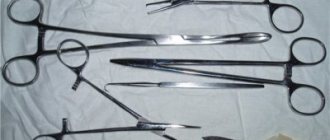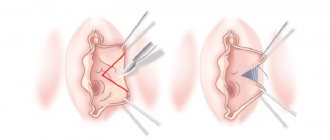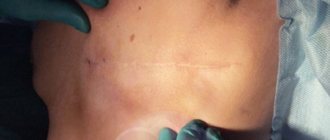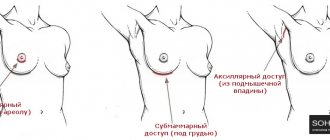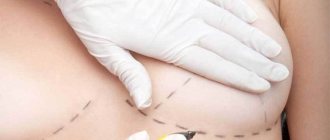- Home page
- Plastic surgery
- Mammoplasty
- Breast augmentation
Augmentation mammoplasty is one of the first places in popularity among operations in the field of plastic surgery . Women's desire to make their breasts more seductive prompts them to turn to the help of surgeons. No less often, patients at the plastic surgery clinic are women who complain of lost volume and shape of the mammary glands after pregnancy and lactation. In such situations, the problem can be solved through a breast lift.
Today in Moscow there are a huge number of plastic surgery centers that perform breast augmentation by installing implants. Of these, we can highlight the Sharm Gold clinic, which occupies a leading position in this direction.
Who is indicated for breast augmentation surgery?
Breast augmentation is performed solely at the request of a woman who is dissatisfied with the appearance of her bust. There are no medical indications for such an intervention.
Breast plastic surgery with implant installation is recommended for patients in the following cases:
- the shape and size of her own mammary glands do not suit the woman and cause psychological discomfort;
- for congenital defects of breast development - unilateral or bilateral absence of mammary glands, micromastia, asymmetrical mammary glands;
- the mammary gland was removed due to injury or cancer and requires reconstructive surgery;
- it is necessary to solve the problem of replenishing sagging, lacking breast volume and loss of elasticity;
- breast implants require replacement - the only reason that can be considered objective for breast replacement.
Is it worth doing - yes or no?
Mammoplasty is a very individual procedure, and you should do it exclusively for yourself in order to feel more confident and get the figure you dreamed of. But you shouldn’t follow someone’s lead, fulfill other people’s wishes, or just try a new look on yourself.
Be sure to attend at least one consultation with a surgeon, he will be able to give a better assessment of whether mammoplasty is worth doing. Remember that in some cases an additional breast lift may be required, and sometimes you can limit yourself to it and completely forget about implants until a certain age.
Breast augmentation is an ideal option for you if:
- You know exactly what you want
- Are you worried that your bust is too small?
- You are unhappy with changes in your bust, it has lost shape and volume after pregnancy, weight loss or with age
- One breast is noticeably different in size or shape from the other
- One or both breasts have failed to develop normally.
Today it is a simple and harmless procedure, and prices are affordable for everyone, which allows any woman to create the shape of her dreams. Endoprostheses do not interfere with lactation, do not move anywhere, cannot be palpated and are completely invisible. This is a modern miracle of plastic surgery and mammoplasty.
Breast augmentation: contraindications
Surgical breast augmentation is an operation that may be accompanied by certain risks, therefore there are a number of contraindications to its implementation (they can be absolute or relative).
Breast augmentation with implants is absolutely contraindicated in patients who have the following pathologies:
- serious pathologies of the heart and blood vessels;
- varicose veins;
- chronic pathologies in the acute stage;
- hemocoagulation disorders;
- oncopathology.
Pregnant and lactating women will have to postpone breast enlargement. At least six months must pass from the moment of cessation of lactation to contacting a plastic surgeon.
A separate absolute contraindication to mammoplasty is the woman’s incapacity, which was established by the court. This means that, due to her mental and mental state, the patient is not able to fully understand the essence of the operation and what consequences it threatens.
Plastic breast augmentation also has relative contraindications. Surgical intervention is undesirable, but can be performed on patients with the following pathologies:
- chronic cardiovascular, endocrine and ophthalmological diseases in the compensation stage;
- autoimmune diseases;
- benign tumors of the mammary glands;
- obesity.
Breast augmentation surgery is not recommended for women who have not yet given birth and for underage girls.
Contraindications
- the presence of infection in the body, local or systemic
- malignant neoplasms
- progressive fibrocystic mastopathy, considered precancerous, without mastectomy
- blood diseases affecting blood clotting
- taking medications that reduce blood clotting
- any systemic diseases in the stage of decompensation
- demonstration by the patient of signs of psychological instability (inadequate psychological attitudes and motivations)
- pregnancy, breastfeeding
- ptosis breasts, no breast lift behavior
- radiation injuries, ulcers, history of vascularization disorders
- menstruating at the time of surgery
- not reaching the age of 18
Relative contraindications:
- presence of menstruation at the time of surgery;
Breast augmentation: implants
Implants used in modern plastic surgery to enlarge the mammary glands have different volumes, shapes (round or anatomical), filler (can be smooth or textured), filler (filled with silicone-based gel, saline solution or biogel). All of them are absolutely safe for the female body and are durable.
The surgeon helps you choose the most suitable implant, taking into account the woman’s wishes and many other factors that will help avoid complications in each specific case.
For example, when selecting an implant shell, surgeons give preference to a rough (textured) one, since the capsule around the installed implant in this case will be thinner. Thanks to this, the risks of developing capsular contracture (the most dangerous complication of breast augmentation surgery) are minimized.
How much breast augmentation surgery costs depends to a large extent on the type of implants chosen by the patient for breast replacement.
Mammoplasty price
The cost of the intervention depends on the correction method, as well as on what implants are used. During an in-person consultation, the surgeon will determine the treatment strategy and also identify possible contraindications. These include:
- age under 18 years;
- some chronic diseases;
- any acute diseases;
- bleeding disorders;
- diseases of the mammary glands;
- any neoplasms in the glands;
- pregnancy, lactation.
Surgery will not prevent changes that occur as a result of weight fluctuations, aging, pregnancy, or breastfeeding.
Breast augmentation in women: types of surgical access
In the arsenal of modern plastic surgery there are several techniques that allow breast enlargement. They have varying degrees of invasiveness and duration of lasting results.
The types of surgical access also differ:
- incision in the inframammary fold - inframammary access;
- incision along the nipple areolas - periareolar access;
- incision in the axillary region - axillary approach;
- incision in the navel area - transumbilical access.
The patient can choose the type of access independently. However, you should listen to the opinion of the plastic surgeon, since in some situations the choice of surgical approach is quite limited. Caution in this matter is dictated, first of all, by the need to hide all postoperative sutures.
How is female breast augmentation performed?
When using the submammary approach, the surgeon makes an incision along the natural crease under the breast. This method of installing implants for breast augmentation is considered the safest, since the surgeon is able to visually monitor the progress of the operation. After such augmentation mammoplasty, the mammary glands lower slightly, their appearance becomes more natural, and postoperative scars fade and become almost invisible in the fold under the breast. A contraindication to this type of access is micromastia (too small breast size).
The periareolar type of surgical approach involves making an incision that affects the areola of the nipple or the lower part of the areola. Such an operation should be avoided by women planning pregnancy and breastfeeding in the future, as there is a risk of trauma to the mammary gland, which can disrupt lactation function. The advantages of this technique include the inconspicuousness of the seams, which, if necessary, can be hidden with tattooing.
Breast augmentation via the axillary approach requires the use of endoscopic equipment, which allows visualization of the vessels and the implant bed. This type of access has its advantages - postoperative scars are hidden in the armpits, and there is no risk of capsular contracture. This high-tech type of augmentation mammoplasty is traditionally recommended for patients whose immediate plans include pregnancy and breastfeeding. Thanks to the use of the axillary approach, surgeons are able to preserve the integrity of the breast tissue, and, accordingly, the woman’s lactation function. However, there is also a significant drawback of the method - it is impossible to install large implants (more than 400 ml).
The first endoscopic breast augmentation operations were often performed using a transumbilical approach - the surgeon made an incision in the navel. However, in this case, breast augmentation with silicone is technically very difficult, so implants were used, which after installation were filled with saline solution.
Types of access
Breast implants are currently installed in 3 ways.
Transaxillary (axillary) access:
Its use assumes that the implants will be installed through a small incision of up to 4 cm in the armpit. Specialized medical equipment is used as an assistant in this procedure. The use of a special surgical sleeve allows you to reduce the trauma of the operation to a minimum; the marks after the operation are invisible and are located in the natural axillary fold. After just a few months, traces of the operation become completely invisible. This type of access is most often used for slender, thin patients; implants are installed under the muscle. The mammary glands are not affected, so the feeding function is not impaired.
Advantages:
- complete absence of postoperative sutures in the chest area;
- With this method of plastic action, breast tissue is not affected, no injury occurs - the feeding function remains unchanged;
- the edges of the implants are absolutely invisible even in very thin girls, and all thanks to a special installation from the armpit area under the muscle;
- The length of postoperative sutures is only up to 4 cm; they are hidden in the armpits and therefore are not noticeable even in the early stages of rehabilitation.
The effectiveness of the proposed breast augmentation technique will depend on the professionalism of the plastic surgeon, as well as the anatomical characteristics of each patient. This installation method is suitable for thin girls; implants are selected in small sizes (the most popular are 325 and 370g).
Submammary access
The implants are installed through an incision in the area of the inframammary fold. This method allows you to install especially large implants, more than 400 g. (from 4-5 breast size). Access is considered the easiest to implement.
Flaws:
- the implant cannot be installed completely under the muscle, and due to this, the lower edge of the implant can be contoured and palpated with thin (less than 1 cm) breast tissue;
- the presence of traces from surgery under the breast;
Periareolar/paraareolar approach
The implants are installed through an incision along the contour of the breast areola.
The periareolar approach involves an incision along the edge of the areola, and the suture is camouflaged by the contrast of pigmented and uncolored skin. With the para-areolar approach, the incision is made directly on the areola, and due to the special properties of the areola tissue, it does not leave scars, the seam is practically invisible. A few months after the operation, the scars from the suture can be polished off with a laser and permanent camouflage can be created, clearly matching the tone of your natural areola color. The size of the implant to be installed depends on the size of the patient’s mammary glands. If accessed through the areola, nipple sensitivity may be reduced.
Simultaneously with breast augmentation surgery with implants using a peri/para-areolar approach, it is possible to perform surgery to correct the areolas and periareolar mastopexy – breast lift.
Implant installation method (technique)
When choosing the method of implant installation and the type of implant itself (round or anatomical), the surgeon is guided by the individual characteristics of the patient: the presence of chest deformation, ptosis (drooping) of the mammary glands, asymmetry of the mammary glands, skin properties and size (thickness) of the mammary gland.
The ideal option is to install an implant under the pectoralis major muscle. In this case, the muscle completely covers the implant, due to which it is not contoured or palpated. In combination with the transaxillary (axillary) approach, the operation of installing an implant under the pectoralis major muscle turns out to be the least traumatic and only in this case the mammary gland itself is not affected (there is no contact of the instrument/implant with the mammary gland).
The antipode of the above method of breast augmentation is the installation of an implant under the fascia of the mammary gland. In this case, a necessary condition is the presence of a sufficient volume of glandular tissue to hide the edges of the implant.
The combined method of breast augmentation surgery combines the two previous ones - the lower part of the implant is placed under the mammary gland, and the upper part under the pectoralis major muscle.
Augmentation via transaxillary access, 325g, after 10 months
Some subtleties
As a result of the operation, it is impossible to obtain absolutely symmetrical breasts, because There is no initially symmetrical breast due to the asymmetry of the left and right halves of the chest, postural disorders and the initial asymmetry of the mammary glands, areolas and nipple.
Beautiful photos on the Internet of the results of operations, as a rule, are taken from the most favorable angle, beneficial for the presentation of the result of the operation. Sutures, effects depending on the method of implant installation, constitutional features and postoperative swelling are not included in the frame. As a result, for many, these factors accompanying the operation become an unpleasant surprise.
If there is significant asymmetry, a good result can only be achieved with additional correction – lifting and correction of the areolas (one or both breasts). The surgeon will tell you about this during your consultation.
What you need to pay attention to:
- Seam location. With submammary access - under the breast, with transaxillary access - under the armpits, periareolar - along the areola.
- Test for animation effects when bending over and when tensing the pectoralis major muscle: “double bubble” (double fold effect), “waterfall symptom”, ripples over the implant.
Often patients are interested in what the interthoracic gap will be after surgery. Initially, the interpectoral gap depends on the place of attachment of the pectoralis major muscle to the sternum and cannot be changed. This gap can be identified during a consultation with a surgeon before surgery, for example, using a test to bring the mammary glands together, or by tensing the pectoralis major muscle in a certain way if the mammary gland is not developed. To reduce this distance, a combination of breast augmentation with implants and the lipofilling method is used. The fat cell is laid around the implant and visually reduces the interbreast space.
Keep in mind that the cost of breast augmentation largely depends on the quality of the implants, anesthesia, the experience of the surgeons and the subsequent stay in the recovery room. When you want to save on a procedure, think twice. A price that is too low is suspicious if we are talking about a fairly complex operation. Therefore, we recommend that you familiarize yourself with the surgeons’ qualifications, the clinic’s documents, the operation agreement, and attend a personal consultation with at least three specialists. And make a comprehensive decision.
In advance, as prescribed by the doctor for consultation, you must:
- Stop taking medications that affect blood clotting (hormonal drugs, NSAIDs, drugs based on acetylsalicylic acid, vitamins)
- Reduce nicotine dose/quit smoking ten days before surgery
We provide everything you need before the operation
On the day of the operation, the patient comes to the clinic on an empty stomach at the appointed time, where he communicates with the surgeon, anesthesiologist, fills out the necessary documents, takes photographs and marks, after which the operation begins.
You only need to have an identification document with you - the clinic The clinic provides disposable clothing, food, a comfortable room, access to the Internet and television and all necessary medical care.
The operation is carried out under the supervision of an anesthesiological team
The operation takes about 45 minutes.
Upon completion of the operation, special postoperative underwear is put on, after which the patient is transferred to the recovery room, and is under the supervision of doctors during the entire stay. The nurse makes all necessary appointments and helps with feeding and hygiene needs.
No drainage or suture removal
The next day, an examination is carried out, and the patient is discharged with all necessary recommendations.
There are no drainages and no suture removal, because... the operation is performed minimally and using absorbable threads and special skin glue. Postoperative examinations take place after: a week, two weeks, a month, three months, six months, a year.
Recommendations after surgery
In the first week, pain is present, but does not cause much discomfort.
Over the next two
For months you will be able to sleep only on your back. You should also not lift any weights (two kilograms or more) or actively engage in sports. Driving will also have to be avoided for 2 weeks after surgery, as seat belts can dislodge the implants. You will receive more detailed recommendations from our specialists during your consultation.
Soon, in addition to the desired change in forms, a person’s psychological state and attitude change - self-confidence and optimism appear.
Breast augmentation (mammoplasty): rehabilitation
The first 2-3 days after surgery the patient is in the hospital. After discharge, she will need to come to the clinic several times for dressing changes.
After installation of breast implants, the patient is recommended to wear compression garments for at least one month. You can't take it off even while sleeping.
During rehabilitation, a woman should avoid physical activity, not carry heavy objects, and try not to raise her arms up.
Restrictions also apply to visiting the pool, sauna, and beach. The optimal sleeping position during the recovery period after surgery is lying on your back.
In the first month after surgery, a capsule is formed around the installed implants. To prevent postoperative complications, strict adherence to all the surgeon’s instructions is necessary.
In one and a half to two months, the mammary glands will drop a little, look as natural as possible, and swelling will subside.
Breast enlargement: consultation before surgery
The success and complete safety of the procedure largely depends on your revelation during the first and subsequent consultations with the doctor. You will be asked several questions about your health, wishes and lifestyle.
Before you have plastic surgery, be prepared to discuss:
- Why do you want it
- What result do you want to achieve?
- Do you have any untreated diseases or drug allergies?
- Do you take medications, vitamins, nutritional supplements, alcohol, tobacco or drugs?
- What plastic interventions were there before?
You should also be interested in obtaining an ideal result from the manipulation, so do not hesitate to ask your doctor when visiting a consultation:
- Do you have preferred hospitals to perform this procedure? If yes, which hospitals?
- What can I expect from plastic surgery and how long does the recovery period last?
- What are the risks or possible complications associated with my procedure?
- How can I avoid risks as much as possible?
- Will the baby's ability to feed breast milk be affected?
- What will my bust look like in the future? After pregnancy? After feeding?
Breast augmentation surgery: possible complications
Like any surgical intervention, augmentation mammoplasty threatens with negative consequences, the development of which can be associated both with incorrect conduct of the operation and non-compliance with medical recommendations for the management of the rehabilitation period by the patient herself. The most common complications after breast augmentation surgery include:
- development of suppuration of the postoperative wound;
- the appearance of hematomas;
- displacement of implants;
- formation of capsular contracture.
To prevent and timely identify the above complications, it is necessary to systematically visit a plastic surgeon who monitors the survival of the implant and wound healing.
Plastic surgery for breast augmentation improves the aesthetic appearance of the bust, restores women's confidence in their attractiveness and increases their self-esteem. In order to be confident in the result of the operation, a woman must responsibly choose a surgeon to whom she will entrust breast augmentation. Moscow is overflowing with offers from clinics providing similar services. The Sharm Gold plastic surgery clinic is rightfully considered one of the best. The clinic’s doctors are surgeons of the highest category, whose experience allows them to perform augmentation mammoplasty as effectively as possible and without complications, which is confirmed by numerous reviews from grateful patients.
Recovery period
The postoperative recovery period lasts from 24 to 48 hours, with additional reduced activity for the next few days. You will most likely experience discomfort, pain and swelling in the breast area during these days. There may be some swelling for 2-4 weeks which may make it appear larger than expected, this is normal and goes away quickly. You must wear special underwear for 2 months. Physical activity and normal activities can only be resumed with your doctor's approval. This will happen when post-operative swelling decreases and the scars at the incision line disappear.
You will receive specific instructions, which may include:
- How to care for your bust after
- What medications can you take to help healing or reduce the risk of infection?
Be sure to ask your plastic surgeon about what to expect during your recovery period.
It is important! Follow all your doctor's instructions; this is the key to successful mammoplasty and a quick recovery. Do not expose sutures at surgical incision sites to excessive friction or increased activity during the healing phase.
The cost of plastic surgery may vary depending on the type and cost of implants that will be used.
The price also includes:
- Surgeon's fee
- Costs of using hospital or surgery center resources
- Anesthesia
- The cost of the implants themselves
- Postoperative clothing and care
- Some medical tests and tests
Please call the administrators for the cost of breast augmentation..
When choosing a plastic surgeon, remember that experience with and comfort with breast implants is just as important as the final cost of the surgery.
Work examples
Breast augmentation: cost in Moscow
| Type of service | Service cost |
| Consultation with a plastic surgeon | For free |
| New generation 3D modeling | 5000 rub. |
| Surgical correction of mammary gland hypoplasia by retromammary endoprosthetics from a subglandular approach without the cost of a prosthesis (on both sides) | 300,000 rub. |
| Surgical correction of breast hypoplasia by submuscular endoprosthetics from the subglandular approach without the cost of an implant (on both sides) | 300,000 rub. |
| Surgical correction of breast hypoplasia by submuscular transareolar endoprosthetics without the cost of an implant (on both sides) | 300,000 rub. |
| Surgical correction of breast hypoplasia from the anterior axillary approach without the cost of an implant (on both sides) | 280,000 rub. |
| Surgical correction of breast hypertrophy with resection of glandular tissue (both sides) | 300,000 rub. |
| Surgical correction of mammary gland hypertrophy with resection of glandular tissue and nipple relocation (on both sides) | 400,000 rub. |
| Surgical correction of mammary gland hypertrophy with resection of glandular tissue and nipple relocation (on both sides) | 80,000 rub. |
| Surgical correction of nipples (both sides) | 70,000 rub. |
| Surgical correction of breast ptosis (both sides) | 200,000 rub. |
| Surgical correction of breast ptosis with one-stage endoprosthetics without the cost of an implant (on both sides) | 400,000 rub. |
Show all price
Reconstructive mammoplasty
The final stage of mastectomy or partial resection is reconstruction of one or two mammary glands. According to the time of implementation, it is divided into immediate and delayed. For reconstruction, artificial materials (expanders, implants) and autologous tissues (own flaps) are used.
Reconstructive mammoplasty helps to recreate the volume and shape of the gland, and also reconstruct the nipple-areolar complex. This reconstruction is carried out by:
- transplantation of flaps and grafts (pigmented skin, cartilage tissue);
- use of synthetic prostheses
- tattoo application.
Frequently asked questions about breast augmentation surgery
Depends on the clinic where breast augmentation is planned. The cost of breast augmentation surgery is determined taking into account the type of implant and the technical complexity of the intervention.
Among the operations that plastic surgery deals with, breast augmentation is the most popular. The safety of augmentation mammoplasty has been proven for years. The development of modern technologies and improvement of the quality of implants ensures high efficiency and the absence of negative consequences for the female body.
The first breast augmentation surgery with implants was performed in 1962. From that moment to this day, you can make breasts with silicone. However, today there are alternatives to this implant filler - biogel, saline solution.
The shape of the implants, as well as their size, is chosen by the patient independently. The opinion of a plastic surgeon is only advisory. To visualize the expected result of the operation, modern clinics offer a 3D modeling service.
In order to fully enjoy the appearance of the “new” breasts, the patient needs to have a little patience. Full recovery after surgery (reduction of swelling, fading of scars and acquisition of a natural shape by the mammary glands) occurs in approximately three months.





